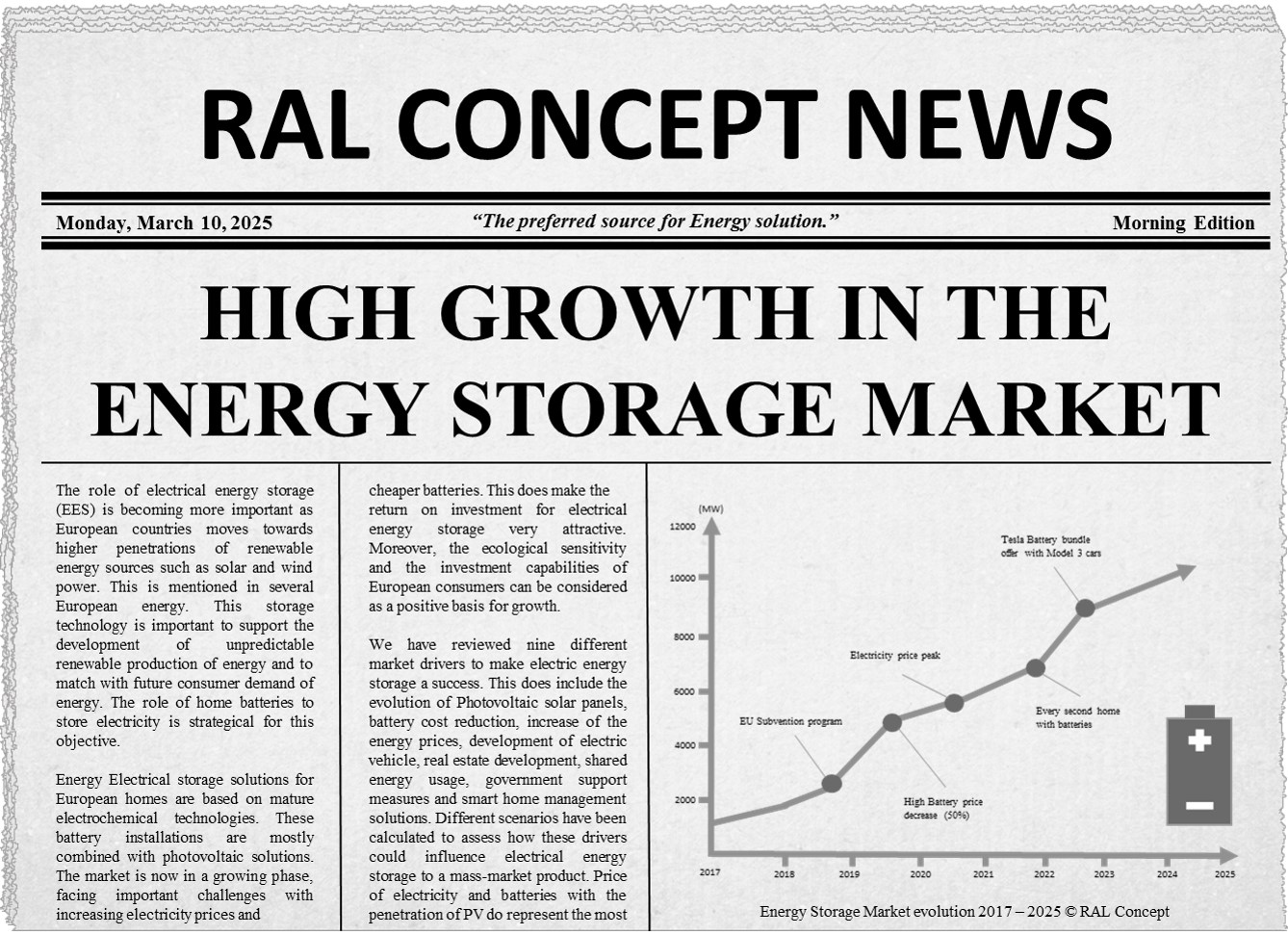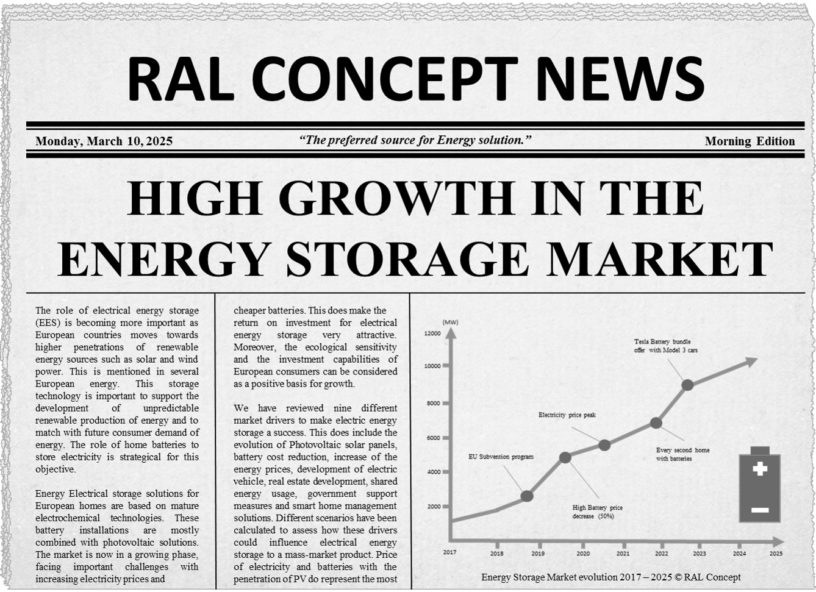The role of electrical energy storage (EES) is becoming more important as the European continent moves towards higher penetrations of renewable energy such as solar and wind power. Home batteries could even become a high growth product by 2025 as shown in this fictional Newspaper!

Storage Batteries shall be part of our future homes for the following reasons:
- It’s the perfect combination with Photovoltaic (PV) panels for savings generated from directly produced energy
- Cost management with the possibility to reduce electricity expenses by storing electricity obtained at lower prices (off-peak times), for a later usage at higher prices (peak times)
- Security as storage batteries can be used for redundancy or to avoid losses
Despite these advantages, Electrical energy Storage has still difficulties to penetrate the residential market, but why? The large investment requirement for battery energy storage is currently one of the main barriers to a broader adoption. A return on investment could only be possible with an acceptable timeframe of 10 years or less. This could be possible with these market drivers:
1. Battery price reduction
Today’s Batteries including home installation can cost in average 5’000 to 30’000 EUR. Some reports indicate that Battery technology prices could decrease up to 50% in the next 5 years. This could definitely accelerate the acquisition of an EES solution coupled with a PV installation. Tesla with its Powerwall battery product has announced a price of around 3’000 USD for a capacity of 6.4 kWh. This would represent a price of 468 USD per kWh, which would become an important purchase argument for the retail market.
2. Energy price increase
The current low energy retail price discourages any Battery purchase because the return of investment would be far too long with the optimisation of the energy usage. Energy savings are possible when it is possible to save electricity with off-peak prices and use in when the price is at a Peak. This is also called Peak Shaving.
We can simply say that higher the price of kWh is, higher the savings is expecting to be. The good news is that the electricity prices are about to increase!
3. Subventions: Government support with purchase subsidies or tax reductions
Scheme to encourage and support the adoption of Photovoltaic and solar panels installations are essential to encourage a faster adoption of this technology in the retail market. Subsidies can be proposed under the form of a government grant or a tax reduction to support the investment of EES. Subsidies are already used in several markets for retail customers such as Japan which has introduced a new program to support 2/3 of Li-ion batteries costs. Germany does support as well up to 30% of PV installation in combination with an EES solution. We can believe that these types of model would increase in the future.
4. Positive sales evolution of Photovoltaic
The combination of Photovoltaic Panels with Battery Storage is the perfect mix. Roles are clearly defined; Solar panels produce electricity and battery stores it. The electricity stored can later be used when the kWh price is at his peaks. This does improve the profitability of both Battery and PV installation. We can, therefore, assume that the success of EES is highly linked with the success of PV evolution.
5. Positive sales evolution of EV
There are many pros to link the evolution of Electric Vehicle with the adoption of energy storage. Some studies say that EV will increase the domestic household electricity usage of a 1/3. This does represent an important optimisation potential of energy. Moreover, it has to be noticed that EV drivers are generally more concerned about ecology, which is also positive for a potential global PV and EES investment as mentioned in my first blog about “Triple Play of Energy“. This is surely the reason why Tesla is promoting a storage solution.
6. Financing solution
The possibility to lease a storage solution to get a faster financial benefit could be a major argument. This could lower down the important risk of investment and increase the attractiveness of EES. Innovative leasing models are already in place in Germany, Japan and North America. For example, the financing company Orix in Japan offers leasing proposals for a combined PV and EES installation.
7. Smart home “Management” solution
Smart home is an interconnected house with a management console. The purpose is to optimise costs with heating management, improve comfort with lighting atmospheres and increase security with cameras or movement detectors. EES would just be an additional energy component to manage over distance. This would also make possible the remote management of electricity import and export for cost optimisations.
8. Shared energy usage (Energy crowd)
Sharing and using renewable resources are getting more popular. The IIMT (international institute of management in technology) of Fribourg has developed a concept of Crowd-energy to share the production of energy of several PV installations among multiple households. Battery storage would then be the base system to store and share energy within a community, districts or residences. This could be a way to improve the popularity and profitability of EES systems in urban areas.
9. Real estate market “New house built”
Newly built houses could be designed from the start with combined Smart Home technologies with PV and EES systems. We can already see that most of today’s new built homes are equipped with solar panels. This does confirm that these technologies could become part of any standard future household equipment. Moreover, the financing of a home with a long-term hypothec does allow to include important investments from the start with a very low financing conditions. For example, in Switzerland, with low-interest rates of 1 to 1.5% for long-term hypothec.
10. Security
Last but not least, Electrical energy Storage has initially been designed as a backup to cover short-term network disruptions. Interruptions could, for example, damage expensive equipment’s (Computers, alarms and other household equipment’s). Nevertheless, it has to be noticed that Central European countries have a very high Grid reliability as you can see on these figures from Statista. This is why Security cannot become a reason for a massive growth in Europe.
Mass Market Product?
Yes, we can believe that Energy Electrical Storage has the potential to become a mass-market product in Europe. The real question is when? Most important Market Drivers are related to the costs. If the price of electricity gets higher and prices of batteries are decreasing of 30 to 50%, this scenario could become possible within the next 10 years or less.
What do you think?
This article is based on a thesis I wrote in 2016 for the IIMT of Fribourg, Switzerland called “What are the measures and actions to take to make the battery storage a mass-market product for the residential market in Switzerland?”.





Leave a Reply